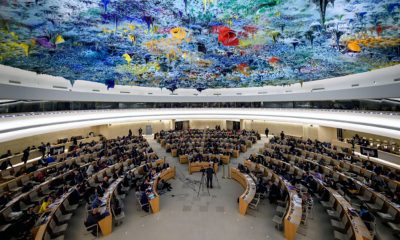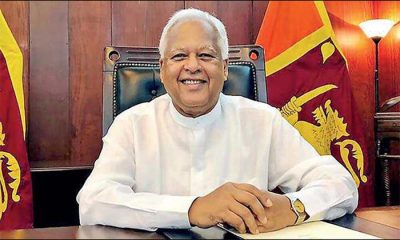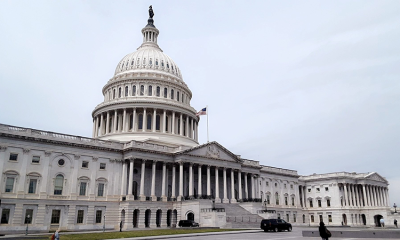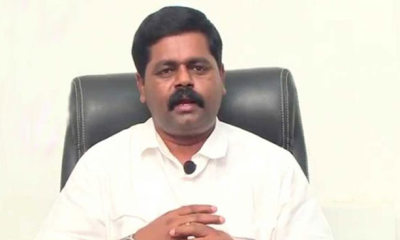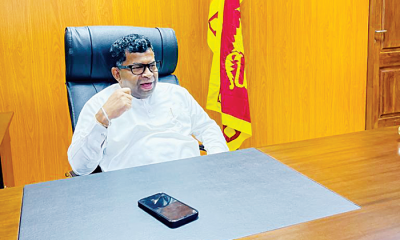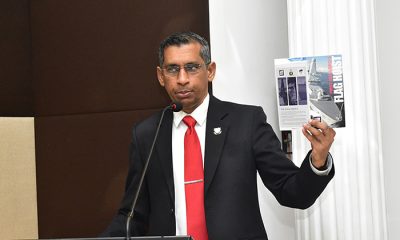Features
First Provincial Council election, intrigue intensifies and disastrous IPKF helidrop

(Excerpted from volume ii of the Sarath Amunugama autobiography)
In Paris I learnt that JRJ, urged on by the Indians, had called for Provincial Council elections. He did not have the support of Premadasa who left the country on a long foreign tour telling the President that his astrologers were forcing him to leave the country as he had entered a ‘malefic period’. The SLFP too boycotted the election paving the way for Vijaya-Chandrika’s SLMP to be the chief adversary of the UNP at the hustings. As expected the UNP won the besieged election and proceeded to appoint Chief Ministers from the ranks of their second tier Parliamentarians, who deprived of the fleshpots as MPs, preferred to lord it over in their home towns and also put their hand into the till of the provincial budget.
JRJ’s earlier idea of appointing senior public servants as Chief Ministers was shot down by the Cabinet that did not welcome another set of competitors who were bound to emerge as grandees in their own bailiwicks. JRJ already enfeebled politically was in no position to oppose the politically oriented Chief Ministers who had their individual patrons in the Cabinet. He however used his authority to shift many non-performing seniors as Governors in the Provinces giving them powers to checkmate the excesses of the CMs.
Having strong Governors was a way of reinforcing the center as they were his representatives upholding the unitary nature of the State. All this had to be done in the face of implacable hostility by the JVP which unleashed its killer squads on each and every one who supported the Indo-Lanka agreement and the 13th Amendment.
In the North and East the Indians had established a client Chief Minister Varatharaja Perumal who had to bear the brunt of the LTTE assault. It was indeed a ‘time of trouble’ with murderous violence in all parts of the country. The growth model which had shown much promise was ripped apart and its chief advocates like Ronnie de Mel and Nissanka Wijeratne resigned signaling that the JRJ regime had lost its way.
While in Paris I was asked by WIF to visit the UN in New York for a consultation. Since my wife and daughter, Ramanika, were living in Rue Cambron in Paris at that time I thought of taking them also to the US as they had not been there before though they had traveled extensively in Europe. The main attraction was that my lifelong friend, Professor H.L. Seneviratne and his family had settled down in Charlottesville where the famous old University of Virginia was located. This was a University established by Thomas Jefferson and was one of the oldest in the country.
After my meeting in New York we took a train through Washington to the American South, past many famous civil war battle sites, to Charlottesville where we were met by the Seneviratnes. This was my first visit to the south though later as Minister of Finance I would visit Washington at least twice a year for IMF and World Bank meetings. Most times I would spend those intervening weekend holidays with the Seneviratnes in Charlottesville. At that time it was a peaceful small University town and certainly not the hate mongering venue of Trump’s fanatics that it later became.
Virginia is famous because Jefferson’s home and farm were located there. Many important events relating to the early days of the Republic are associated with his home which was called ‘Montecello’. We visited ‘Montecello’ which is now a historical site. Jefferson is reputed to have had a tolerant view of race relations, even having a black mistress who was relocated to Paris. The University of Virginia which was a brainchild of Jefferson was partly designed by him. Today it is better known because Edgar Allan Poe lived and wrote his macabre poems there.
We spent a wonderfully peaceful holiday with our lifelong friends and flew back to Paris and its bustling social life. This included visits by Lester and Sumitra Peries who were recognized as leading Asian film makers and promoters of serious cinema, especially after the incapacitation and eventual death of Satyajit Ray. I remember a visit to the Nantes film festival which had the Asian Cinema as its theme that year. We drove all the way and back in the Ambassador’s car and had a chance to enjoy the French countryside as well as provincial cuisine in small inns along the way.
A fellow participant at these French film festivals was Adoor Gopalakrishnan who was a friend of Lester and Sumitra and an award winner for his simple tales of South Indian life which were a welcome relief from the mega Hindi and Tamil extravaganzas which made India [Bollywood] a bigger film producer than Hollywood. But they were not recognized as art by the managers of French Film festivals.
Political Intrigues
I went back to Colombo to find it seething with intrigue. The Prime Minister was making it clear that he did not approve of the decisions of the President regarding the Indo-Lanka issue. Relations between the two had deteriorated to such an extent that they were loath to talk to each other. Premadasa appeared to be planning to make his own bid, if his claims for Presidential nomination were overlooked byJRJ and the party. He started using a different color [saffron] to distance himself from the ‘greens’ in his publicity campaign. This was replicated when he painted bridges and buildings constructed by his ministry in saffron.
Premadasa also started to build up his own coterie of supporters within the parliamentary group. He had banked heavily on senior Justice Raja Wanasundera prevailing on his colleagues of the Supreme Court to call for a referendum regarding the 13th amendment. When that failed he made it clear to the country that his heart was not in the Provincial Councils as he had been the progenitor of the concept of empowering the Pradeshiya Sabhas which he supervised as the Minister of Local Government. In spite of the political imperatives for devolution, particularly to the North and East, Premadasa saw no need for a second tier represented by the Provincial Councils.
At last JRJ appeared to be retaliating when he removed the PM’s favourites Sirisena Cooray and Mallimaratchchi from the working committee of the UNP. He also overlooked Wanasundera’s claims and appointed Parinda Ranasinghe as the Chief Justice. Insiders knew that it was a blow aimed at the PM. With Premadasa sulking in his tent and Ronnie de Mel resigning his crucial portfolio when the President was isolated, JRJ was in an unenviable position. But he was making his political calculations and realized that Premadasa’s candidature was necessary if the UNP was to face the looming presidential election successfully.
In this he was fortified by the views of Mrs Jayewardene and her ’round table’ in Braemar which echoed the public perception that without the Prime Minister as candidate UNP chances of victory were slim. All this confusion was adding to the confidence of the JVP and its military wing which was going on the rampage particularly in the south against both the UNP and the traditional left. Later when Mrs. Bandaranaike refused to accept JVP conditions during their dialogue with the SLFP, the JVP turned on her as well and even hatched plans to assassinate her.
Violence Intensified
This was perhaps the most unsettling period in JRJ’s two terms of office. He was constantly disturbed by daily reports from the countryside. In the south the JVP was threatening to bring the administration to a halt. In the North the IPKF was increasingly acting on their own and could not be controlled either by the President or by Dixit the Indian High Commissioner.
The Indians were severely embarrassed by their inability to militarily defeat the LTTE which was inflicting heavy blows to the IPKF. The IPKF in the early stages was manned by ‘peacekeepers’ rather than fighting generals and senior military staff officers. They were more keen on winning the ‘hearts and minds’ of the LTTE than in fighting them.
RAW intelligence was of little use because the LTTE were outsmarting them. This inadequacy was clearly seen in the Indian para drop which was planned at their highest levels to eliminate the LTTE leadership, which I will describe later. While this turn of events tended to isolate JRJ, he turned to Gamini Dissanayake as a reliable ally and a credible interlocutor with the Indian High Commissioner and New Delhi. I was drafted by Gamini to be his advisor at this difficult time. We did not know at that time that JRJ had authorized Lalith Athulathmudali to open negotiations with the JVP to end their violence by lifting the proscription and electing a new Parliament.
He would accommodate the JVP which would be given three portfolios. In this the JVP even scared the SLFP when they demanded the portfolio of Defence. Lalith jumped the gun and announced a successful result with a representative of the JVP leadership. But the JVP denied any involvement and the purported negotiator fled the country.
It was later found that if the JVP had been given more time for their internal consultations a deal may have been concluded .This period was traumatic for JRJ because his party network built up as his political legacy which he referred to when he boasted that ‘the countries electoral map’ could now ‘be rolled up’ echoing Napoleon’s claim that he had rolled up the map of Europe, was being dismantled through violence by the JVP. This was clear when the UNP Chairman and Secretary who had been handpicked by JRJ were assassinated within a few weeks of each other. His response was to appoint the military trained Ranjan Wijeratne to hold both these positions.
I was present in ‘Braemar’ when JRJ received the news that his Mirissa retreat ‘Red Cliffs’ had been burnt down with all the antique furniture in it. He was disturbed by the irrationality of it all. The MPs and party leaders of the South met him and demanded stern measures. The MP for Habaraduwa, Mr. GVS Silva had been killed a few days earlier. They asked for police powers of an ASP. Gazetted officers were authorized to bury victims without an inquest under Emergency powers. It is an indication of the critical state of affairs of that time that JRJ was willing to give into them. The note that he penned agreeing is now in my possession.
However Sepala Attygalle who had been summoned for this conference argued against issuing that order on the grounds that it would confuse the armed services and the police. He prevailed when he gave an assurance that he would personally respond to requests for the safety of the MPs and their supporters.
IPKF Helidrop
Perhaps the biggest debacle of the IPKF in their war in Sri Lanka was the air drop of its elite paratroopers onto the grounds of the Jaffna campus with the objective of eliminating the leaders of the LTTE. It is an irony of history that the food drop from the air into Jaffna which humiliated JRJ (Parippu drop) was matched by the disaster of the Indian helidrop which humiliated the Indian army and is considered even today as a low point in its modern history. I can recount here what happened that day because by chance I became the liason between the Indian High Commissioner and JRJ that fateful evening.
CHOGM or the conference of Heads of Commonwealth governments was to be held in Vancouver in mid October 1987. JRJ was very keen to attend this meeting because Rajiv Gandhi and Margaret Thatcher were to attend and he could discuss the local conflict, which was going from bad to worse, at the level of heads of state. He had made plans to leave that very night for Vancouver on an assurance given by Dixit that the LTTE will be decisively beaten in Jaffna following the helidrop. Perhaps the plan, which would have been approved by Rajiv himself, was for him to go with an IPKF victory to the Vancouver meeting with JRJ.
JRJ asked me to personally proceed to the Indian High Commissioner’s residence and get the latest information on the air drop. 1 drove to Dixit’s residence to find him deep in conversation with General Sunderjee who had come to Colombo to oversee the IPKF offensive planned to give a decisive turn to the northern war. ‘The Indians were severely challenged by the LTTE fighters – an intolerable situation for the biggest fighting force in South Asia.
Sunderjee was a small made but physically trim and active general who was in Colombo in his army uniform with Dixit signifying that he was actively engaged in the operation. He wanted me to inform JRJ that everything was going according to plan and that he could leave for the Vancouver meeting early in the morning.
I reported this to JRJ but he was anxious to get an assurance from Dixit himself and wanted me bring him to “Breamar”. So I drove Dixit and Sunderjee in my car to JRJs residence and after their brief meeting drove them back to India House and went home to sleep.
When I got up the following morning all hell had broken loose. Acting on RAW information that the LTTE were to meet in their office in a building on the Campus of Jaffna University, crack Indian paratroopers were airdropped to round up the LTTE central committee which would have meant the virtual end of the fighting.
The top LTTE leadership was to have been arrested and held in Indian custody. But this plan had gone horribly wrong notwithstanding the confidence of Sunderjee and Dixit. What had happened was that information regarding the airdrop had been leaked and the LTTE gunmen were ready and waiting to shoot at the descending Paras who were sitting ducks as they floated down from the Jaffna skies. Suspicion fell on the Indian army top brass in the North. Many of them were “peace keepers” not fighting units and they had established close ties with LTTE leaders.
After the debacle military inquiries showed their incompetence and some officers were cashiered and others were shunted aside. After retirement some of these officers published their memoirs and sought to justify their activities in Jaffna. But they were not believed and were later seen at seminars in New Delhi intervening vehemently when the airdrop disaster was discussed. Let us listen to General Shanta Kottegoda on the Helidrop fiasco.
“The LTTE having intercepted the IPKF radio communication had prior information of the impending raid and fortified the defences in the University and were prepared to take on the IPKF. When the airborne troops landed in the University complex they came under heavy fire from small arms, machine guns and snipers of the LTTE from all directions. The IPKF could only helidrop the first group of paracommandos and had to abort the air operation. The operation ended in disaster and the IPKF lost almost 35 men who died in action”.
In the event JRJ did not go to Vancouver as planned. He nominated Gamini Dissanayake to take a message to Rajiv much to the annoyance of Hameed who was the nominal leader of our delegation in JRJs absence. One can speculate that this airdrop disaster marked the “crossing of the Rubicon” as far as both the Indian Government and the LTTE were concerned. The Indian army intensified its attacks on the LTTE. The LTTE in turn killed 25 `Jawans’ in Mannar. Prabhakaran and his intelligence units may have decided that they would not have traction with Rajiv who was therefore to be assassinated. It also marked the depths of despair of the proud Indian Army and is recorded as a “black mark” in its history. General Sunderjee retired not long after.
Features
The heart-friendly health minister

by Dr Gotabhya Ranasinghe
Senior Consultant Cardiologist
National Hospital Sri Lanka
When we sought a meeting with Hon Dr. Ramesh Pathirana, Minister of Health, he graciously cleared his busy schedule to accommodate us. Renowned for his attentive listening and deep understanding, Minister Pathirana is dedicated to advancing the health sector. His openness and transparency exemplify the qualities of an exemplary politician and minister.
Dr. Palitha Mahipala, the current Health Secretary, demonstrates both commendable enthusiasm and unwavering support. This combination of attributes makes him a highly compatible colleague for the esteemed Minister of Health.
Our discussion centered on a project that has been in the works for the past 30 years, one that no other minister had managed to advance.
Minister Pathirana, however, recognized the project’s significance and its potential to revolutionize care for heart patients.
The project involves the construction of a state-of-the-art facility at the premises of the National Hospital Colombo. The project’s location within the premises of the National Hospital underscores its importance and relevance to the healthcare infrastructure of the nation.
This facility will include a cardiology building and a tertiary care center, equipped with the latest technology to handle and treat all types of heart-related conditions and surgeries.
Securing funding was a major milestone for this initiative. Minister Pathirana successfully obtained approval for a $40 billion loan from the Asian Development Bank. With the funding in place, the foundation stone is scheduled to be laid in September this year, and construction will begin in January 2025.
This project guarantees a consistent and uninterrupted supply of stents and related medications for heart patients. As a result, patients will have timely access to essential medical supplies during their treatment and recovery. By securing these critical resources, the project aims to enhance patient outcomes, minimize treatment delays, and maintain the highest standards of cardiac care.
Upon its fruition, this monumental building will serve as a beacon of hope and healing, symbolizing the unwavering dedication to improving patient outcomes and fostering a healthier society.We anticipate a future marked by significant progress and positive outcomes in Sri Lanka’s cardiovascular treatment landscape within the foreseeable timeframe.
Features
A LOVING TRIBUTE TO JESUIT FR. ALOYSIUS PIERIS ON HIS 90th BIRTHDAY

by Fr. Emmanuel Fernando, OMI
Jesuit Fr. Aloysius Pieris (affectionately called Fr. Aloy) celebrated his 90th birthday on April 9, 2024 and I, as the editor of our Oblate Journal, THE MISSIONARY OBLATE had gone to press by that time. Immediately I decided to publish an article, appreciating the untiring selfless services he continues to offer for inter-Faith dialogue, the renewal of the Catholic Church, his concern for the poor and the suffering Sri Lankan masses and to me, the present writer.
It was in 1988, when I was appointed Director of the Oblate Scholastics at Ampitiya by the then Oblate Provincial Fr. Anselm Silva, that I came to know Fr. Aloy more closely. Knowing well his expertise in matters spiritual, theological, Indological and pastoral, and with the collaborative spirit of my companion-formators, our Oblate Scholastics were sent to Tulana, the Research and Encounter Centre, Kelaniya, of which he is the Founder-Director, for ‘exposure-programmes’ on matters spiritual, biblical, theological and pastoral. Some of these dimensions according to my view and that of my companion-formators, were not available at the National Seminary, Ampitiya.
Ever since that time, our Oblate formators/ accompaniers at the Oblate Scholasticate, Ampitiya , have continued to send our Oblate Scholastics to Tulana Centre for deepening their insights and convictions regarding matters needed to serve the people in today’s context. Fr. Aloy also had tried very enthusiastically with the Oblate team headed by Frs. Oswald Firth and Clement Waidyasekara to begin a Theologate, directed by the Religious Congregations in Sri Lanka, for the contextual formation/ accompaniment of their members. It should very well be a desired goal of the Leaders / Provincials of the Religious Congregations.
Besides being a formator/accompanier at the Oblate Scholasticate, I was entrusted also with the task of editing and publishing our Oblate journal, ‘The Missionary Oblate’. To maintain the quality of the journal I continue to depend on Fr. Aloy for his thought-provoking and stimulating articles on Biblical Spirituality, Biblical Theology and Ecclesiology. I am very grateful to him for his generous assistance. Of late, his writings on renewal of the Church, initiated by Pope St. John XX111 and continued by Pope Francis through the Synodal path, published in our Oblate journal, enable our readers to focus their attention also on the needed renewal in the Catholic Church in Sri Lanka. Fr. Aloy appreciated very much the Synodal path adopted by the Jesuit Pope Francis for the renewal of the Church, rooted very much on prayerful discernment. In my Religious and presbyteral life, Fr.Aloy continues to be my spiritual animator / guide and ongoing formator / acccompanier.
Fr. Aloysius Pieris, BA Hons (Lond), LPh (SHC, India), STL (PFT, Naples), PhD (SLU/VC), ThD (Tilburg), D.Ltt (KU), has been one of the eminent Asian theologians well recognized internationally and one who has lectured and held visiting chairs in many universities both in the West and in the East. Many members of Religious Congregations from Asian countries have benefited from his lectures and guidance in the East Asian Pastoral Institute (EAPI) in Manila, Philippines. He had been a Theologian consulted by the Federation of Asian Bishops’ Conferences for many years. During his professorship at the Gregorian University in Rome, he was called to be a member of a special group of advisers on other religions consulted by Pope Paul VI.
Fr. Aloy is the author of more than 30 books and well over 500 Research Papers. Some of his books and articles have been translated and published in several countries. Among those books, one can find the following: 1) The Genesis of an Asian Theology of Liberation (An Autobiographical Excursus on the Art of Theologising in Asia, 2) An Asian Theology of Liberation, 3) Providential Timeliness of Vatican 11 (a long-overdue halt to a scandalous millennium, 4) Give Vatican 11 a chance, 5) Leadership in the Church, 6) Relishing our faith in working for justice (Themes for study and discussion), 7) A Message meant mainly, not exclusively for Jesuits (Background information necessary for helping Francis renew the Church), 8) Lent in Lanka (Reflections and Resolutions, 9) Love meets wisdom (A Christian Experience of Buddhism, 10) Fire and Water 11) God’s Reign for God’s poor, 12) Our Unhiddden Agenda (How we Jesuits work, pray and form our men). He is also the Editor of two journals, Vagdevi, Journal of Religious Reflection and Dialogue, New Series.
Fr. Aloy has a BA in Pali and Sanskrit from the University of London and a Ph.D in Buddhist Philosophy from the University of Sri Lankan, Vidyodaya Campus. On Nov. 23, 2019, he was awarded the prestigious honorary Doctorate of Literature (D.Litt) by the Chancellor of the University of Kelaniya, the Most Venerable Welamitiyawe Dharmakirthi Sri Kusala Dhamma Thera.
Fr. Aloy continues to be a promoter of Gospel values and virtues. Justice as a constitutive dimension of love and social concern for the downtrodden masses are very much noted in his life and work. He had very much appreciated the commitment of the late Fr. Joseph (Joe) Fernando, the National Director of the Social and Economic Centre (SEDEC) for the poor.
In Sri Lanka, a few religious Congregations – the Good Shepherd Sisters, the Christian Brothers, the Marist Brothers and the Oblates – have invited him to animate their members especially during their Provincial Congresses, Chapters and International Conferences. The mainline Christian Churches also have sought his advice and followed his seminars. I, for one, regret very much, that the Sri Lankan authorities of the Catholic Church –today’s Hierarchy—- have not sought Fr.
Aloy’s expertise for the renewal of the Catholic Church in Sri Lanka and thus have not benefited from the immense store of wisdom and insight that he can offer to our local Church while the Sri Lankan bishops who governed the Catholic church in the immediate aftermath of the Second Vatican Council (Edmund Fernando OMI, Anthony de Saram, Leo Nanayakkara OSB, Frank Marcus Fernando, Paul Perera,) visited him and consulted him on many matters. Among the Tamil Bishops, Bishop Rayappu Joseph was keeping close contact with him and Bishop J. Deogupillai hosted him and his team visiting him after the horrible Black July massacre of Tamils.
Features
A fairy tale, success or debacle

Sri Lanka-Singapore Free Trade Agreement
By Gomi Senadhira
senadhiragomi@gmail.com
“You might tell fairy tales, but the progress of a country cannot be achieved through such narratives. A country cannot be developed by making false promises. The country moved backward because of the electoral promises made by political parties throughout time. We have witnessed that the ultimate result of this is the country becoming bankrupt. Unfortunately, many segments of the population have not come to realize this yet.” – President Ranil Wickremesinghe, 2024 Budget speech
Any Sri Lankan would agree with the above words of President Wickremesinghe on the false promises our politicians and officials make and the fairy tales they narrate which bankrupted this country. So, to understand this, let’s look at one such fairy tale with lots of false promises; Ranil Wickremesinghe’s greatest achievement in the area of international trade and investment promotion during the Yahapalana period, Sri Lanka-Singapore Free Trade Agreement (SLSFTA).
It is appropriate and timely to do it now as Finance Minister Wickremesinghe has just presented to parliament a bill on the National Policy on Economic Transformation which includes the establishment of an Office for International Trade and the Sri Lanka Institute of Economics and International Trade.
Was SLSFTA a “Cleverly negotiated Free Trade Agreement” as stated by the (former) Minister of Development Strategies and International Trade Malik Samarawickrama during the Parliamentary Debate on the SLSFTA in July 2018, or a colossal blunder covered up with lies, false promises, and fairy tales? After SLSFTA was signed there were a number of fairy tales published on this agreement by the Ministry of Development Strategies and International, Institute of Policy Studies, and others.
However, for this article, I would like to limit my comments to the speech by Minister Samarawickrama during the Parliamentary Debate, and the two most important areas in the agreement which were covered up with lies, fairy tales, and false promises, namely: revenue loss for Sri Lanka and Investment from Singapore. On the other important area, “Waste products dumping” I do not want to comment here as I have written extensively on the issue.
1. The revenue loss
During the Parliamentary Debate in July 2018, Minister Samarawickrama stated “…. let me reiterate that this FTA with Singapore has been very cleverly negotiated by us…. The liberalisation programme under this FTA has been carefully designed to have the least impact on domestic industry and revenue collection. We have included all revenue sensitive items in the negative list of items which will not be subject to removal of tariff. Therefore, 97.8% revenue from Customs duty is protected. Our tariff liberalisation will take place over a period of 12-15 years! In fact, the revenue earned through tariffs on goods imported from Singapore last year was Rs. 35 billion.
The revenue loss for over the next 15 years due to the FTA is only Rs. 733 million– which when annualised, on average, is just Rs. 51 million. That is just 0.14% per year! So anyone who claims the Singapore FTA causes revenue loss to the Government cannot do basic arithmetic! Mr. Speaker, in conclusion, I call on my fellow members of this House – don’t mislead the public with baseless criticism that is not grounded in facts. Don’t look at petty politics and use these issues for your own political survival.”
I was surprised to read the minister’s speech because an article published in January 2018 in “The Straits Times“, based on information released by the Singaporean Negotiators stated, “…. With the FTA, tariff savings for Singapore exports are estimated to hit $10 million annually“.
As the annual tariff savings (that is the revenue loss for Sri Lanka) calculated by the Singaporean Negotiators, Singaporean $ 10 million (Sri Lankan rupees 1,200 million in 2018) was way above the rupees’ 733 million revenue loss for 15 years estimated by the Sri Lankan negotiators, it was clear to any observer that one of the parties to the agreement had not done the basic arithmetic!
Six years later, according to a report published by “The Morning” newspaper, speaking at the Committee on Public Finance (COPF) on 7th May 2024, Mr Samarawickrama’s chief trade negotiator K.J. Weerasinghehad had admitted “…. that forecasted revenue loss for the Government of Sri Lanka through the Singapore FTA is Rs. 450 million in 2023 and Rs. 1.3 billion in 2024.”
If these numbers are correct, as tariff liberalisation under the SLSFTA has just started, we will pass Rs 2 billion very soon. Then, the question is how Sri Lanka’s trade negotiators made such a colossal blunder. Didn’t they do their basic arithmetic? If they didn’t know how to do basic arithmetic they should have at least done their basic readings. For example, the headline of the article published in The Straits Times in January 2018 was “Singapore, Sri Lanka sign FTA, annual savings of $10m expected”.
Anyway, as Sri Lanka’s chief negotiator reiterated at the COPF meeting that “…. since 99% of the tariffs in Singapore have zero rates of duty, Sri Lanka has agreed on 80% tariff liberalisation over a period of 15 years while expecting Singapore investments to address the imbalance in trade,” let’s turn towards investment.
Investment from Singapore
In July 2018, speaking during the Parliamentary Debate on the FTA this is what Minister Malik Samarawickrama stated on investment from Singapore, “Already, thanks to this FTA, in just the past two-and-a-half months since the agreement came into effect we have received a proposal from Singapore for investment amounting to $ 14.8 billion in an oil refinery for export of petroleum products. In addition, we have proposals for a steel manufacturing plant for exports ($ 1 billion investment), flour milling plant ($ 50 million), sugar refinery ($ 200 million). This adds up to more than $ 16.05 billion in the pipeline on these projects alone.
And all of these projects will create thousands of more jobs for our people. In principle approval has already been granted by the BOI and the investors are awaiting the release of land the environmental approvals to commence the project.
I request the Opposition and those with vested interests to change their narrow-minded thinking and join us to develop our country. We must always look at what is best for the whole community, not just the few who may oppose. We owe it to our people to courageously take decisions that will change their lives for the better.”
According to the media report I quoted earlier, speaking at the Committee on Public Finance (COPF) Chief Negotiator Weerasinghe has admitted that Sri Lanka was not happy with overall Singapore investments that have come in the past few years in return for the trade liberalisation under the Singapore-Sri Lanka Free Trade Agreement. He has added that between 2021 and 2023 the total investment from Singapore had been around $162 million!
What happened to those projects worth $16 billion negotiated, thanks to the SLSFTA, in just the two-and-a-half months after the agreement came into effect and approved by the BOI? I do not know about the steel manufacturing plant for exports ($ 1 billion investment), flour milling plant ($ 50 million) and sugar refinery ($ 200 million).
However, story of the multibillion-dollar investment in the Petroleum Refinery unfolded in a manner that would qualify it as the best fairy tale with false promises presented by our politicians and the officials, prior to 2019 elections.
Though many Sri Lankans got to know, through the media which repeatedly highlighted a plethora of issues surrounding the project and the questionable credentials of the Singaporean investor, the construction work on the Mirrijiwela Oil Refinery along with the cement factory began on the24th of March 2019 with a bang and Minister Ranil Wickremesinghe and his ministers along with the foreign and local dignitaries laid the foundation stones.
That was few months before the 2019 Presidential elections. Inaugurating the construction work Prime Minister Ranil Wickremesinghe said the projects will create thousands of job opportunities in the area and surrounding districts.
The oil refinery, which was to be built over 200 acres of land, with the capacity to refine 200,000 barrels of crude oil per day, was to generate US$7 billion of exports and create 1,500 direct and 3,000 indirect jobs. The construction of the refinery was to be completed in 44 months. Four years later, in August 2023 the Cabinet of Ministers approved the proposal presented by President Ranil Wickremesinghe to cancel the agreement with the investors of the refinery as the project has not been implemented! Can they explain to the country how much money was wasted to produce that fairy tale?
It is obvious that the President, ministers, and officials had made huge blunders and had deliberately misled the public and the parliament on the revenue loss and potential investment from SLSFTA with fairy tales and false promises.
As the president himself said, a country cannot be developed by making false promises or with fairy tales and these false promises and fairy tales had bankrupted the country. “Unfortunately, many segments of the population have not come to realize this yet”.
(The writer, a specialist and an activist on trade and development issues . )


